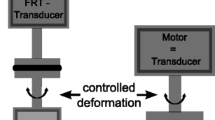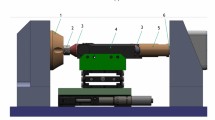Abstract
Described is a detachable fixture for a rotational rheometer, the Sentmanat Extensional Rheometer Universal Testing Platform, which incorporates dual wind-up drums to ensure a truly uniform extensional deformation during uniaxial extension experiments on polymers melts and elastomers. Although originally developed as an extensional rheometer, this highly versatile miniature test platform is capable of converting a conventional rotational rheometer host system into a single universal testing station able to characterize a host of physical properties on a variety of polymer melts and solid-state materials over a very wide range of temperatures and kinematic deformations and rates. Experimental results demonstrating these various testing capabilities are presented for a series of polymers of varying macrostructure and physical states.

















Similar content being viewed by others
References
Meissner J (1972) Trans Soc Rheol 16:405–420
Meissner J (1987) Recent Dev Polym Eng Sci 27:537–546
Cogswell FN (1968) Plastics Polym 36:109–111
Vinogradov GV, Leonov AI, Prokunin AN (1969) Rheol Acta 8:482–490
Macosko C, Lornston J (1972) SPE Tech Papers 19:461–467
Everage AE, Ballman RL (1976) J Appl Polym Sci 20:1137–1141
Connelly RW, Garfield LJ, Pearson GH (1979) J Rheol 23:651–662
Münstedt H (1979) J Rheol 23:421–436
Meissner J, Hostettler J (1994) Rheol Acta 33:1–21
Padmanabhan M, Kasehagen L J, Macosko C (1996) J Rheol 40:473–481
Carter R et al (2001) Polym Rheol Conf 2001 Tech Proc Paper 4:1–4
Wassner E (1999) Determination of true extensional viscosities with a Meissner-type rheometer (RME). In: Proceedings of the Polymer Processing Society 15th Annual Meeting, ‘s-Hertogenbosch, The Netherlands, p 66
Sentmanat MA (2003) Novel device for characterizing polymer flows in uniaxial extension. In: ANTEC ‘03 Soc Plastics Eng Tech Papers 49 (CD-ROM New York)
Sentmanat M (2003) Dual wind-up extensional rheometer. US Patent No. 6 578 413
Sentmanat M Dual (2004) Wind-up drum extensional rheometer. US Patent No. 6 691 569
Sentmanat M, Hatzikiriakos SG (in press) Rheol Acta
Sentmanat M, Wang B, McKinley GH (in press) J Rheol
Meissner J (1985) Chem Eng Commun 33:159–180
Laun HM, Schuch H (1989) J Rheol 33:119–175
Münstedt H, Kurzbeck S, Egersdörfer L (1998) Rheol Acta 37:21–29
McLeish TCB, Larson RG (1998) J Rheol 42:81–110
Sentmanat M, Hatzikiriakos SG (in press) Rheol Acta
Sentmanat M (2004)SER Universal Testing Platform—the ultimate in physical material characterization technology. In: ANTEC ‘04 Soc Plastics Eng Tech Papers 50 (CD-ROM New York)
Acknowledgements
The author would like to gratefully acknowledge Xpansion Instruments, LLC for granting access to the use of their equipment and Prof. Gareth McKinley of MIT for providing the BASF Lupolen 1840H material for extensional flow characterization. Extreme gratitude is also expressed to Prof. Savvas Hatzikiriakos of the University of British Columbia and Prof. John M. Dealy and post-doctoral fellow Dr. Chunxia He of McGill University for their helpful discussions during the preparation of this manuscript.
Author information
Authors and Affiliations
Corresponding author
Appendix
Appendix
Extensional melt rheology and specimen sag
As is the case with any melt rheometer device, unsupported molten polymer may have a tendency to sag owing to the effects of gravity acting on the mass of the sample. These sag effects may be particularly acute for extensional melt rheometers where spans of molten polymer sample are inherently unsupported. Prior extensional rheometer technologies in the literature have attempted to counteract the effects of sag by the use of either an oil bath environment or a pressurized gas cushion to buoy the sample during stretching. However, with proper design of the sample and testing geometry, these buoying techniques may be obviated for polymer melts with relatively low zero-shear viscosity.
To illustrate, consider the case of a uniaxial extension specimen geometry in which the primary axis of extensional deformation lies in the horizontal plane. The specimen geometry can be modeled as a uniform cross-section, simply supported beam span such as the one depicted in Fig. 18a. As a first approximation, specimen sag may be modeled as a classic beam flexure analysis for a concentrated load (the beam’s weight) at the beam’s mid-span. Hence, the beam deflection or amount of specimen sag, y, can be expressed as:
where m is the specimen’s free span mass, g is the gravitational constant, L0 is the specimen span length, E is the characteristic elastic modulus of the specimen at a given melt temperature, and I is the beam’s moment of inertia, a function of the specimen’s cross-sectional geometry. The specimen’s free-span mass is simply equal to the melt density, ρΜ, multiplied by the free-span volume (m=ρΜ L0A where A is the cross-sectional area of specimen). At very low rates of beam deflection typical with polymer sag dynamics, the characteristic elastic modulus E is expected to be a function of the polymer’s zero-shear viscosity η0. Making use of the generalized expressions for solid and fluid tensile stress, σ E , the following expression can be written:
In the limits of small deformations and rates, the following assumption can be made with regard to the rate of deformation:
such that the expression in Eq. 13 can be substituted into Eq. 12 and rearranged to arrive at an expression for the characteristic elastic modulus, E:
where t is equal to the elapsed time of the beam deflection.
As depicted by the beam section geometries in Fig. 18b, c, d, the expression for the moment of inertia, I, is dependent on the cross-sectional beam dimensions with respect to the plane of specimen flexure. Substituting Eq. 14 and the corresponding expressions for m and I, Eq. 11 can be rearranged to obtain an expression for the rate of specimen sag, y/t, such that the following geometry-specific expressions may be written:
Note that the rate of specimen sag scales with the span length raised to the fourth power and is inversely proportional to the square of the beam dimension height. Hence, for an illustrative scenario in which h=10, b=20r and L0 is fixed, a circular cross-section specimen will sag at a rate 133 times faster, and a flat rectangular cross-section specimen at a rate 100 times faster than an upright rectangular specimen, as in the case of an SER sample specimen. An analogous illustration of this result can be made by comparing the deflection of a single sheet of paper suspended flat at one end with the deflection of the same sheet of paper suspended upright on one edge. Thus, by placing a thin, wide specimen on its edge in an upright position as with the SER configuration (as in Fig. 18d), the effects of sag may be greatly reduced by making use of simple beam flexure mechanics.
Rights and permissions
About this article
Cite this article
Sentmanat, M.L. Miniature universal testing platform: from extensional melt rheology to solid-state deformation behavior. Rheol Acta 43, 657–669 (2004). https://doi.org/10.1007/s00397-004-0405-4
Received:
Accepted:
Published:
Issue Date:
DOI: https://doi.org/10.1007/s00397-004-0405-4





